The Limits and Possibilities of Virtual Ethnography in Bangladesh during COVID-19
From the Series: A Collaboratory of Indian Ocean Ethnographies
From the Series: A Collaboratory of Indian Ocean Ethnographies
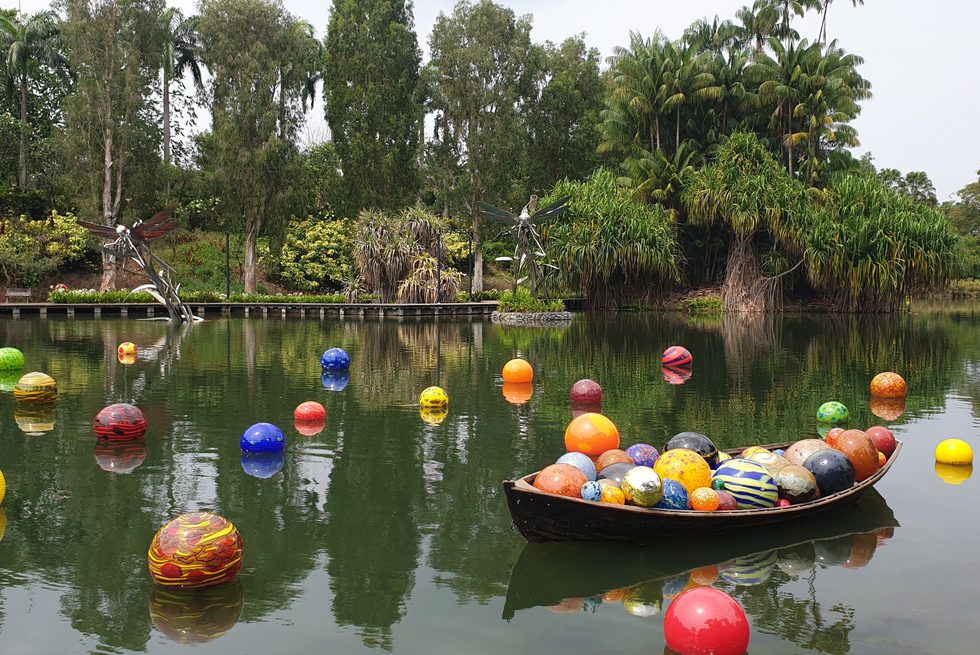
Every year on November 7, thousands of men and women gather at Harinkhola village in Polder 22 of Paikgacha, Khulna, in southwestern Bangladesh, to commemorate the death of Karunamoyee Sarder and the mass movement it sparked. Karunamoyee, a landless widow, was murdered on that day in 1990 while leading a demonstration of villagers protesting against a local shrimp farm owner with political ties. The owner, with the help of armed goons, had tried to take over the polder to start shrimp farming. His men had fired at the procession, killing Karunamoyee and injuring many.
For my Master’s thesis, I wanted to write a microhistory of this movement through the narratives of its principal actors—the villagers of Polder 22—to understand why three decades later Karunamoyee remains such a powerful symbol (Mahtab 2020). A microhistory, I had hoped, would allow me to highlight the complex pictures of solidarity, agency, identity, and politics that unfold through events of collective behavior, which can be easily overlooked from a grand perspective (Uddin 2021).
This attempt at writing history with an ethnographic component had been planned during pre-pandemic times. This decision to do ethnographic fieldwork was based on practical circumstances, without any prior experience on my part or me being familiar at the time with the rich body of literature on historical anthropology (for example, Comaroff and Comaroff 1992). Peltonen’s (2014) theoretical discussions on microhistory as an approach that draws from history and anthropology, however, undoubtedly contributed to the decision. There was a dearth of reliable written records about my field site, and the key actors of the event I wished to document were still alive. These factors, I thought, would give me a unique opportunity to blend the methodologies of microhistory, oral history, and ethnography. The emergence of COVID-19 in March 2020, however, meant that I had to opt for telephone interviews instead of in-person meetings.
Driven by the confluence of global demand, support of international institutions such as the World Bank and the IMF, and national export-oriented policies, shrimp aquaculture rapidly expanded in Bangladesh from the mid-1980s (Pokrant 2014). While the industry promised food security and employment opportunities, in reality, it entailed profound socioeconomic and environmental impact, leading to loss of traditional livelihoods, especially for women (Guhathakurta 2008). In Bangladesh, the industry’s operation has involved widespread criminal activities, including forceful dispossession of land, sexual harassment, rape, and murder (Environmental Justice Foundation 2004). During the last months of 1990, the resistance by the people of Polder 22—who had witnessed shrimp aquaculture’s devastating impact on surrounding polders—grew into a mass movement. In the context of an ongoing nationwide mass movement against General Ershad’s autocratic government, the movement around Polder 22 drew supporters from political parties and NGOs, journalists, and other civil society actors. The people of Polder 22 were able to successfully resist the shrimp industry’s incursion into their land. Paprocki and Cons (2014), while showing how a narrative of overwhelming success may be exaggerated, also write that thirty years later, Polder 22 has lower levels of landlessness, is a safer place to live in the context of climate change, and people have greater control over the production process, compared with surrounding polders where shrimp continues to be farmed.
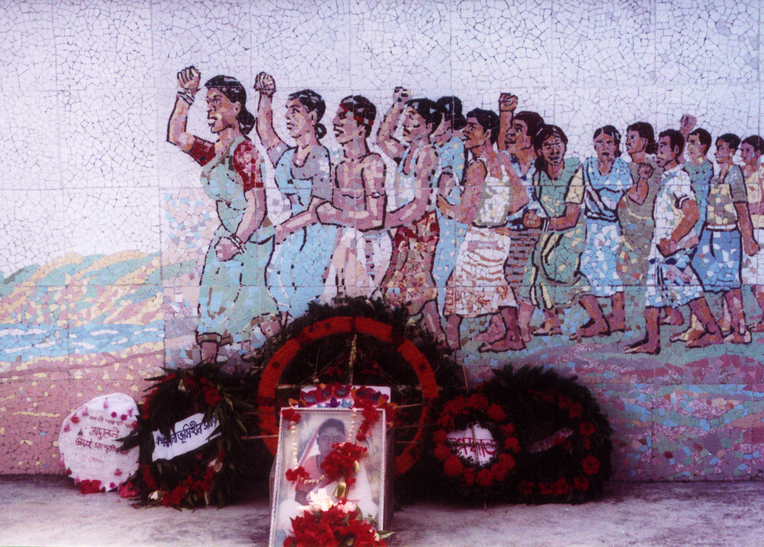
During 2020, as it became increasingly clear that the pandemic had no end in sight, I started contacting members of Karunamoyee’s community over the telephone. I connected with them through ‘Nijera Kori,’ a social mobilization-focused NGO in Bangladesh where I was working as a staff member at the time. Nijera Kori had been active in Polder 22 since the 1980s and had been involved with the movement. Most of the protesting villagers, including Karunamoyee, had been members of the organization’s ‘landless groups.’ While video calls over the internet would have been ideal, Bangladesh’s stark digital divide in terms of both access and knowledge disallowed this. Even with the almost universally-owned cell phones, usage is often marked by divisions of gender (see Lorea et al., and Majumder and Sreekanta’s essays in this series). Luckily, in my case, women respondents had their own phones and were able to speak to me without intermediation or interruption. What proved more challenging was the network strength, which is not uniform over the country and was made worse by the weather. Sometimes my respondents would have to go out of their homes and stand at a particular spot where the signal was comparatively better.
To make matters more complicated, I was calling these people in the immediate aftermath of Cyclone Amphan (May 2020) which had breached the embankments in Polder 22. They had more important issues at hand, such as rebuilding the breached embankments and coping with the damage. I was particularly attentive to accommodate the time and duration of my calls to fit their convenience, but the fact remained that I was approaching them as someone associated with Nijera Kori. I was often left wondering if their willingness to speak to me for such extended periods was from an obligation they felt towards the organization. But the primary implications of conducting phone interviews was in terms of the nature and depth of possible conversations. They proved to be suitable for some aspects, while extremely challenging for others, which required questioning narratives against the grain.
It was important for me to understand the circumstances of their mass movement in their own words, rather than from what I had heard in Nijera Kori. But at times, their narratives felt rehearsed, sorely lacking the subtlety and detail I hoped I could uncover through ethnographic fieldwork. In the thirty years since the event, it was inevitable that individual recollections had given way to a ‘highly idealized, composite image,’ due to the acts of ‘collective recollection and repetition’ (Mitchell 2003), such as yearly commemorations and memorial events. As members of Nijera Kori’s landless groups, many of the villagers had remained involved in NGO advocacy against shrimp aquaculture. Teasing out the politics that guided their actions in 1990 proved challenging over phone calls. This is in no small part because the activism carried out against aquaculture became entangled with other political struggles unfolding over the last several decades.
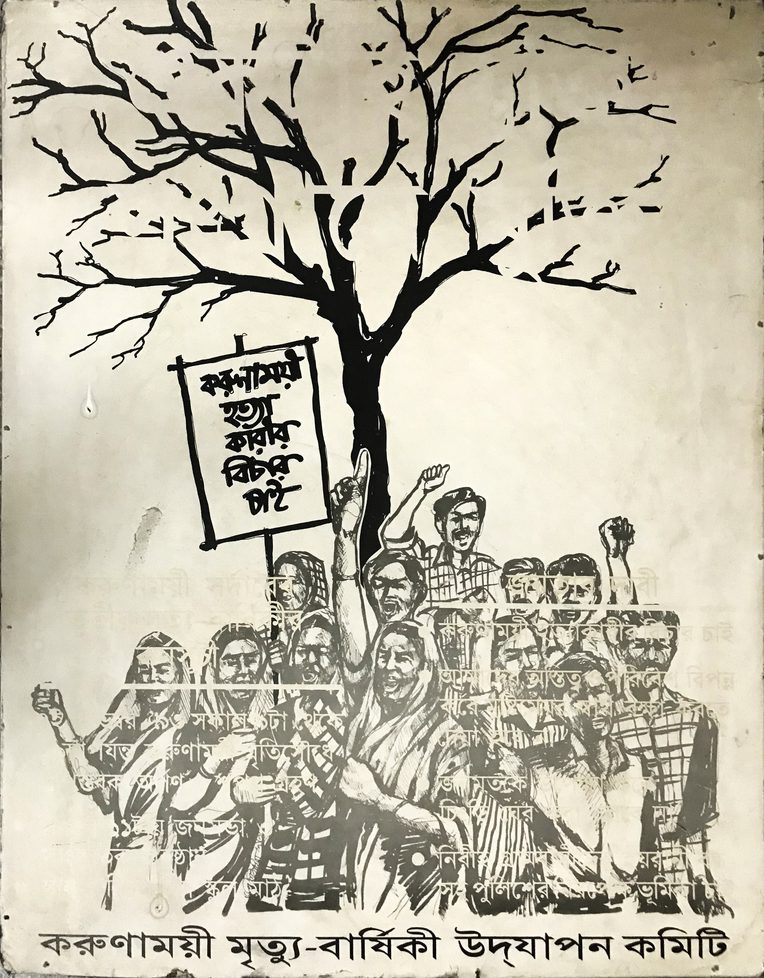
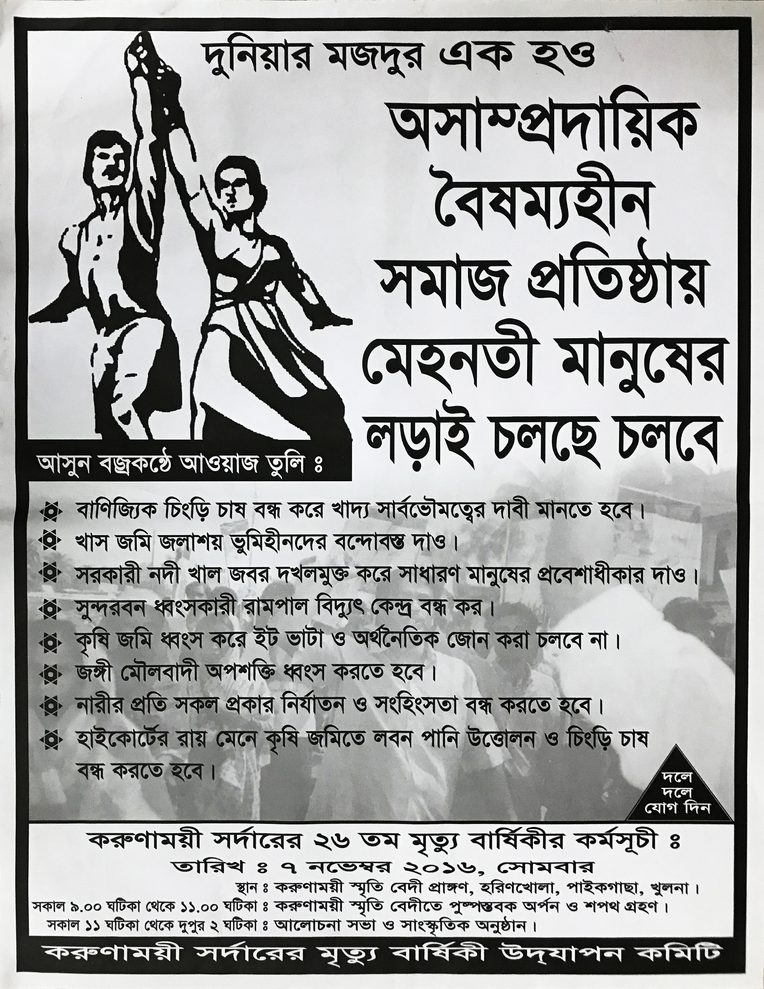
This is evident in the posters produced by Nijera Kori in celebration of ‘Karunamoyee Day’ each year. The poster from 1993, for example, seeks justice for Karunamoyee’s murder and a call to end police harassment of villagers. The poster from 1996, alongside the issue of shrimp cultivation, also demands reforms of the education system, equitable distribution of government-owned land, and a demand for wage equality between men and women. Similarly, diverse issues such as an eradication of communal violence, the trial of 1971 war criminals, the enactment of a common family law for all religions, and a complete stop of the construction of the nearby Rampal Coal Power Plant, are articulated in posters from 1999, 2004, 2014, and 2016.

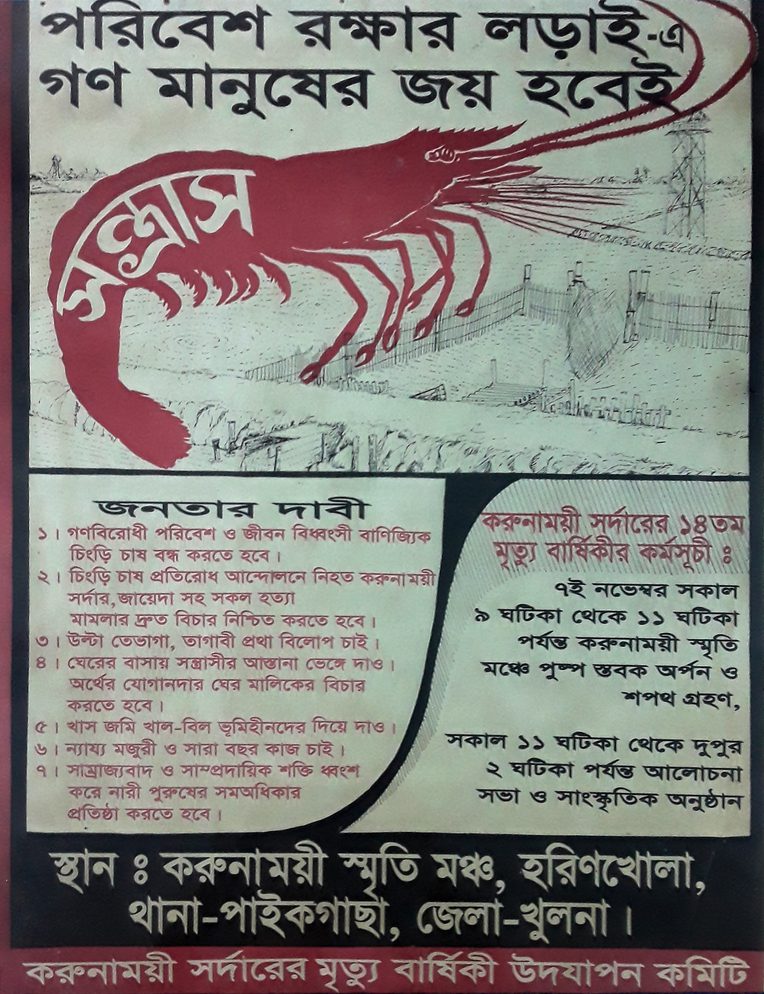
So how had Karunamoyee become a symbol for all these issues—many of them tied to NGO-led activism in Bangladesh? I wanted to see how and to what extent these issues had become central to the evolving politics of the community. In this aspect too, without the ability to engage in sustained, multiple conversations over a period of time, short phone calls provided me with very little.
Telephone conversations did not convey the highly emotional aspects of people’s experiences, and women were not comfortable discussing sensitive topics such as sexual harassment with a person they had never met. With no opportunity for building human connection and trust through face-to-face communication, these conversations were full of hesitations, gaps, and silences. Their emotions were only glimpsed at times through certain experiences they shared. For example, one woman who was just behind Karunamoyee in the procession speaking of November 7, recalled:
“The bullet passed right by my didima [an elderly relative] and hit Karuna... My two small children sitting at home saw smoke rising from the side of Harinkhola... When I returned home, they would not stop crying; they kept asking me why I had gone there... I had tried to take shelter in a house after escaping through the paddy fields; from there the owners chased me away as well. I was a bou manush [young wife] then, I was in wet clothes. Like that, I ran from there.”
This quotation highlights the sense of uncertainty and fear that she had faced at the time, but it is notable because many recollections I heard were devoid of such complexities and detail. Many narratives provided a linear story of heroism in the face of adversity. I had to keep asking my interlocutors to explain everything in greater detail, which proved awkward at times. Often, respondents pointed out that it would be better if I were there in person so that they could show me what shrimp cultivation had done to the surrounding polders. Their lives, they pointed out, are more peaceful and secure because of the absence of shrimp farming in Polder 22.
Ultimately, I managed to write a microhistory that highlights the contingencies, choices, and relationships that shaped the politics of my interlocutors and draws out the connections between their actions and the broader political and economic contexts of Bangladesh. It highlights why people associated aquaculture industry with criminal activities and sexual violence, how people formed solidarity beyond their religious identities, and what they felt they had achieved through the movement that began after Karunamoyee’s death.
As I have shown here, however, many questions that prompted me to look at this collective action remained unanswered. This experience underscored the limitations of phone conversations as an alternative to ethnographic fieldwork. Working through lockdown and carrying out a project shaped by immobility, I could not build authentic connections in my field site. Although my work would have been shaped by my position as a staff member with Nijera Kori and my gender, working in-person would have allowed me to more intimately connect with people through a shared physical presence and the mere act of spending time together outside the confines of a formal interview. I felt, at times, that I came across like a journalist interviewing a witness rather than a researcher empathizing with the stories and struggles people shared with me. At the same time, the politics and emotions that I wanted to highlight were inseparably linked to the sites that I could not experience first-hand—the paths through which they had marched to resist, the embankment near which Karunamoyee was killed, and where the mural was erected—the lands which were at risk of being inundated and on which their livelihoods depend to this day.
The experience that I stumbled through due to the pandemic prompted me to think about what ethnography could offer to historical research, particularly in times of restricted mobility. On one hand, I recorded narratives that I could use to write a detailed history of a social movement on the margins of the grand narrative of the state. For an aspiring historian, it opened up a challenge of looking at sources beyond written texts—oral narratives, posters, songs—to understand the past and gain an appreciation of the importance of social networks when approaching respondents. On the other hand, without detailed personal interactions, without lived or witnessed experience of the site, I am left wondering how truly the narratives I collected reflect the complex, evolving meanings and values that I wanted to understand.
If nothing else, this first taste of ethnography under such extraordinary circumstances has led me to start digging deeper into how anthropology and history could interact. My interest in microhistory stemmed from its focus on agency and the depth of experience it promised in trying to understand events on the margins, while plans for ethnographic fieldwork were based on practical circumstances. In writing my master’s thesis—from what I could not achieve, as much as from what I could—I came to appreciate how ethnography, when possible, can be immensely fruitful in telling stories of human agency within broader socio-political structures. And that messy human element, full of conflicting passions and contingent choices, can only help us better understand societies and specific experiences which are—to paraphrase Lévi-Strauss (1963)—essentially remote to us due to space, time or both at once.
Comaroff, John, and Jean Comaroff. 1992. Ethnography and the Historical Imagination. Boulder, Colo.: Westview Press.
Environmental Justice Foundation (EJF). 2004. Desert in the Delta: A Report on the Environmental, Human Rights and Social Impacts of Shrimp Production in Bangladesh. London: EJF.
Guhathakurta, Meghna. 2008. “Globalization, Class and Gender Relations: The Shrimp Industry in Southwestern Bangladesh.” Development 51, no. 2: 212–219.
Lévi-Strauss, Claude. 1963. Structural Anthropology. Translated by Claire Jacobson and Brooke Grundfest Schoepf. New York: Basic Books.
Mahtab, Moyukh. 2020. “A Microhistory of a Mass Mobilisation: Peasant Agency and Solidarity in the 1990 Anti-Shrimp Movement of Polder 22, Khulna.” Master’s thesis. BRAC Institute of Governance and Development, BRAC University.
Mitchell, Katharyne. 2003. “Monuments, Memorials, and the Politics of Memory.” Urban Geography 24, no. 5: 442-459.
Paprocki, Kasia, and Jason Cons. 2014. “Life in a Shrimp Zone: Aqua- and Other Cultures of Bangladesh's Coastal Landscape.” Journal of Peasant Studies 41, no. 6: 1109- 1130.
Peltonen, Matti. 2014. “What is Micro in Microhistory?” In Theoretical Discussions of Biography: Approaches from History, Microhistory, and Life Writing, edited by Hans Renders and Binne de Haan, 105-118. Leiden, Netherlands: Brill.
Pokrant, Bob. 2014. “Brackish Water Shrimp Farming and the Growth of Aquatic Monocultures in Coastal Bangladesh.” In Historical Perspectives of Fisheries Exploitation in the Indo-Pacific, edited by Joseph Christensen and Malcolm Tull, 107–132. Dordrecht, Netherlands: Springer.
Roy, Dishani, Raka Banerjee, Carola Lorea, Fatema Aarshe, Md. Khaled Bin Oli Bhuiyan, and Mukul Pandey. 2021. “The Sonic and the Somatic: Matua Healing Practices during COVID-19.” Research blog, ConoAsur, January 22.
Uddin, Layli. 2021. “‘Enemy Agents at Work’: A Microhistory of the 1964 Adamjee and Karnaphuli Riots in East Pakistan.” Modern Asian Studies 55, no. 2: 629 - 664.